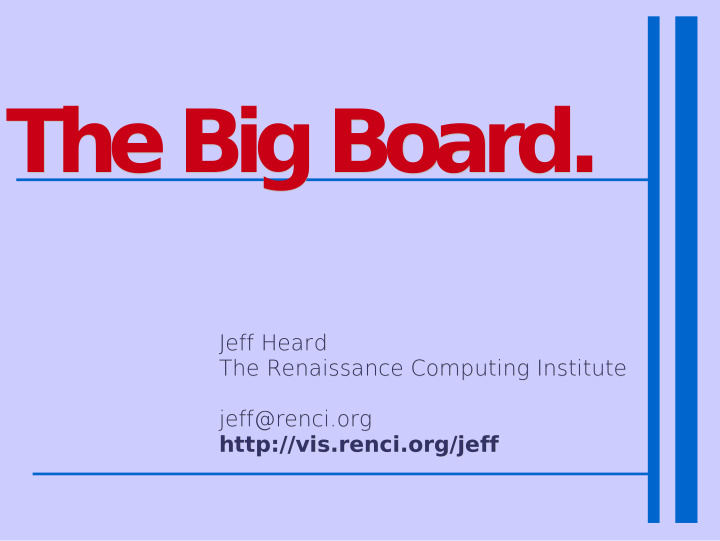



The Big Board. The Big Board. Jeff Heard Jeff Heard The Renaissance Computing Institute The Renaissance Computing Institute jeff@renci.org jeff@renci.org http://vis.renci.org/jeff http://vis.renci.org/jeff
The problem. ● Disasters don't obey state or county lines nor resource constraints. ● Thus resources for one disaster need to be coordinated effectively across boundaries. ● EMs need a geographically coordinated shared workspace. ● Most natural shared workspace is a map.
Existing Solutions. ● Google Maps / Earth – Content is static ● ArcInfo – Solutions are difficult to integrate ● WebEOC – Non georeferenced ● Pen and Paper – Need I really say more?
The Big Board. ● T eleconferencing over maps ● Realtime content creation and generation ● Orthophotography or vector layers ● 100% Haskell with Python server-side. ● Directly uses Hieroglyph, buster, haxr (xml-rpc), mtl (applicative), gtk2hs, parsec, HTTP 4000.x, bytestring.
Why Haskell? ● Memory and speed efficient executables. ● Excellent graphics libraries. ● Reliability through type-safety. ● Rapid development. ● High level of code reuse.
FP vs. T raditional vis. ● Visual Semantics – Visual meaning vs. data and purpose of application. ● Abstracts away from process of drawing. ● Ties visual representation to data closely.
Interactivity via FRP . ● Functional Reactive Programming models interactivity via behaviours and events. ● Behaviours react to events. ● Buster, TBB's FRP system is a broadcast FRP as opposed to an arrow- based FRP .
Postmortem. ● The Big Board: – Less than 1000 lines of app-specific code. ● T wo libraries, plus the beginnings of a third. – Hieroglyph for pure-functional vis graphics. – Buster for “app-orchestration” – Beginnings of GIS library for parsing WKT, WKB, PROJ, and interfacing with libproj2
Advantages of FP . ● Rapid development. ● Encouragement of reuse and small understandable codebase. ● High performance compared to other high-level languages. ● Active and responsive dev community on #haskell and [Haskell-cafe].
Disadvantages of FP . ● Relatively small dev community, ● Dev community overlap with the graphics community is not yet all that large. ● Much of FP is still theory-focused. ● Few colleagues at my office understand FP or think they have time to learn.
Lessons Learned. ● Shortcuts are generally the long way around. ● The type system should be used to concentrate on semantics rather than modularization. ● “pure” functions preferable to IO functions, because it encourages deeper thought about the problem. More reuse, clearer code.
Recommend
More recommend